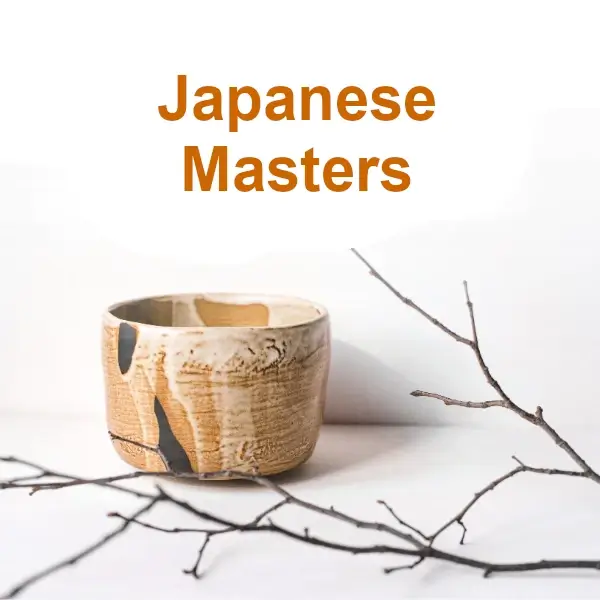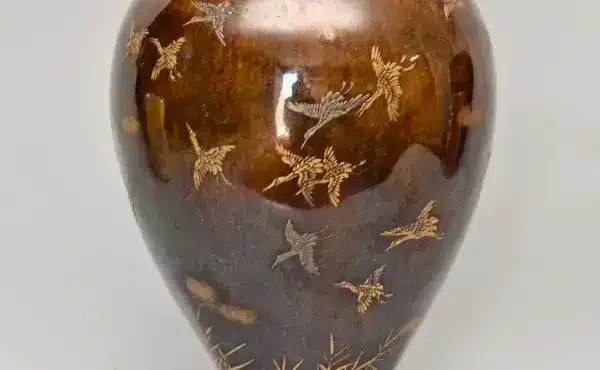Tanuki: The raccoon dog with a magical scrotum and great fortune
Shrouded in Japanese folklore, Tanuki figurines represent more than just decorative statues; they are a reflection of Japan’s rich cultural variety, combining mythology, humor and the promise of good fortune.
Known for their jovial appearance, these mythological beings capture the imagination with their ability to transform and their mischievous nature, as seen in their various representations in popular culture and gastronomy, where they even inspire dishes such as “Tanuki Soba”.
Despite their comical side, symbolized by their prominent anatomy, these creatures are deeply rooted in cultural symbolism, from protection to prosperity, each attribute of their figure tells a story.
Enjoy this journey through the enchanting world of the Tanuki and discover how their figures and other representations have transcended their mythical origin to become a beloved and omnipresent symbol in modern Japanese life.
- Introduction to Tanuki: Between Mythology and Reality
- History and Origin of Tanuki Figures
- Symbolism and Cultural Meanings
- The Seven Virtues of the Tanuki: The Lucky Raccoon Dog
- Tanuki in Japanese Art, Literature and Popular Culture
- Tanuki Figures in Modern Society
- How to Identify an Authentic Tanuki Figure
- Rituals and Beliefs Associated with Tanuki
- Royal Tanuki Conservation: Efforts and Challenges
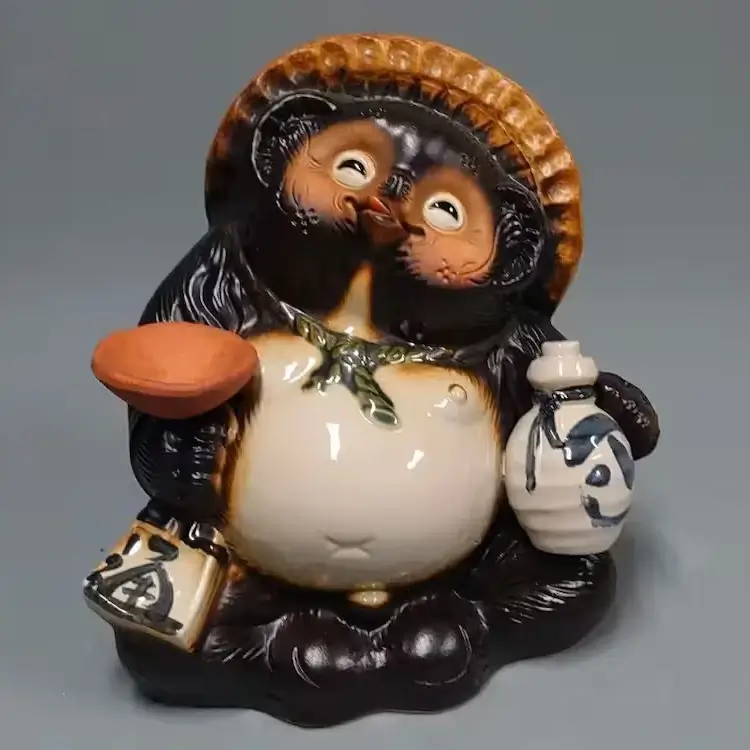
Introduction to Tanuki: Between Mythology and Reality
In Japan’s rich folkloric tradition, Tanuki figurines occupy a special place, balancing between reality and mythology with unique grace.
They are based on the animal of the same name, which is known as the raccoon dog.
Originally from China and popularized in Japan between the 4th and 7th centuries, these beings were initially perceived as malevolent creatures, a legacy of Chinese legends. However, over time, the image of the Tanuki evolved into that of a harmless and humorous character, synonymous with prosperity and good omens.
In Japanese folklore, the Tanuki are known for their ability to transform, initially into beings feared for their mischief and their potential to possess humans. Over the centuries, these creatures have become symbols of fun and prosperity, worshipped in legends and depicted as statues outside bars and restaurants, inviting people to enjoy life with the same carefree attitude that characterizes these prankster spirits.
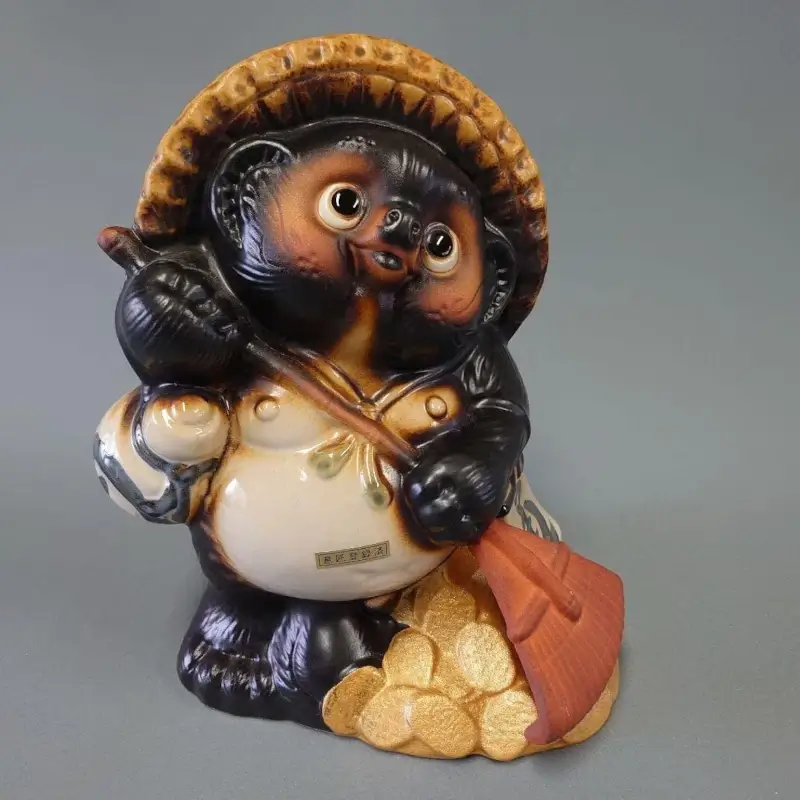
The most notable peculiarity of the Tanuki, highlighted in countless legends and ukiyo-e art, is its magical, oversized scrotum, which, according to the stories, can stretch to unimaginable sizes, being used for all sorts of practical and humorous purposes. This unique feature not only demonstrates the sense of humor present in Japanese culture, but also symbolizes good luck in business, making Tanuki figurines a popular amulet in the commercial arena.
Delving deeper into the article, we will explore the history and origin of these creatures, their deep cultural symbolism, and how these mythical beings continue to influence modern Japanese society, from art to literature and beyond.
History and Origin of Tanuki Figures
The history and origin of Tanuki figures are intertwined with Japanese mythology and folklore, revealing a fascinating evolution of these creatures from feared beings to symbols of generosity and prosperity. Originally, Tanuki were seen as malevolent yōkai with the ability to possess humans and transform, allowing them to perform mischief often at the expense of the unsuspecting. However, over time, the perception of these creatures changed drastically.
Yokai are supernatural creatures of Japanese folklore that range from benevolent spirits to malevolent entities. Originating from ancient traditions and deeply rooted in Buddhist and Shinto beliefs, these beings have evolved throughout Japanese history, especially during the Edo era. Characters such as the Kitsune and the Kappa are emblematic within this mythology.
In feudal Japan, the Tanuki were renowned for their magical power, in particular, their magical scrotum that could stretch to incredible sizes and be used for everything from saving people to serving as a parachute or blanket. This peculiar feature became a symbol of good luck for business, and many Tanuki statues still feature this prominent feature as a prosperity charm.

Buy Tanuki figures
Would you like to have the figure of an authentic Tanuki?
Take home one of these mythological beings.
Over time, the figure of the Tanuki softened, transforming into a more benign character, associated with fun and drink, and eventually evolving into an icon of generosity and prosperity. This transformation is reflected in their representation in statues, often seen in restaurants and stores, where they are believed to attract good luck and fortune.
The mass production of these pieces in Japanese ceramics is attributed to Fujiwara Tetsuzō, a potter from Shigaraki-yaki, and they became extremely popular after Emperor Hirohito’s visit to the city of Koga in 1951.
In contemporary culture, this creature remains a beloved figure, depicted wearing a straw hat, holding a sake bottle and with prominent male attributes, symbolizing its role in Japanese mythology as a yōkai creature full of mystery and magic.
Symbolism and Cultural Meanings
The large, expressive eyes of the Tanuki are interpreted as the importance of making wise decisions and seeing beyond deception.
The presence of a sake bottle symbolizes the ability to learn of those who live life free of worries, embracing a joyful and carefree attitude. This element, along with the depiction playing his belly drum, reflects a peaceful and bold attitude, reminding us to approach life with tranquility and courage.
Interestingly, Tanuki figurines are also associated with good fortune and prosperity, being common in homes and businesses as lucky talismans. This aspect is reinforced by the inclusion of bags of gold in their iconography, suggesting potential growth in wealth and abundance in various aspects of life.
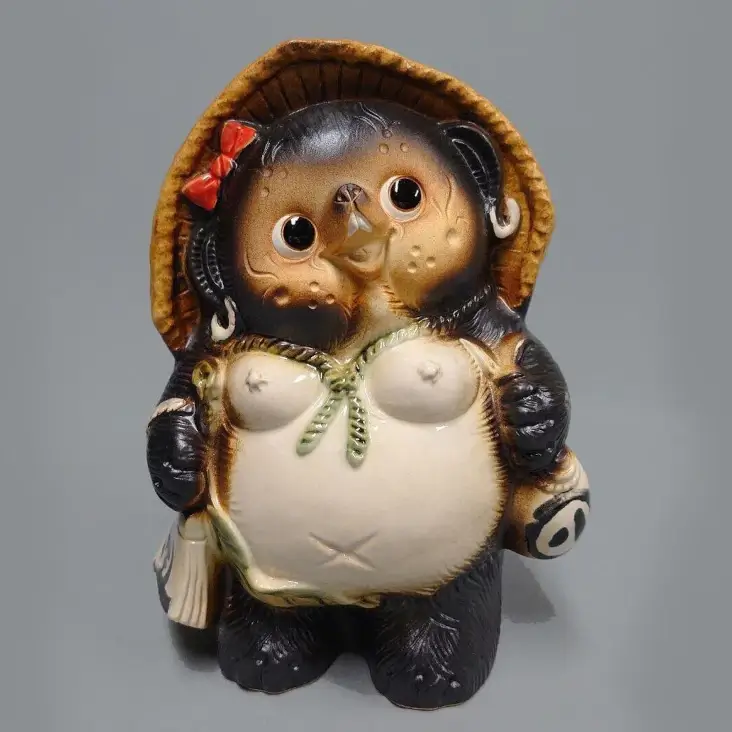
In addition to their physical presence, these raccoon dogs have a prominent place in the culinary field, particularly in restaurants specializing in traditional Japanese dishes. An example of this is “Tanuki Soba”, a type of noodles seasoned with tempura, which incorporates the influence of these beings through decorative elements or names that pay homage to their mischievous reputation.
Transformation is another notable facet of Tanuki’s magical powers, highlighting their ability to mimic human lifestyles and habits. This ability to live almost a lifetime under a human disguise without being easily detected, along with their penchant for pranks and tricks, reinforces their role as playful and mischievous figures within Japanese mythology.
The Seven Virtues of the Tanuki: The Lucky Raccoon Dog
The Seven Virtues of the Tanuki represent a fascinating aspect of Japanese culture, reflecting not only the playful and joyful character of these creatures, but also their connection to good fortune and prosperity.
These virtues, represented by seven symbols are:
- A friendly smile, symbolizing hospitality and warmth.
- A bottle of sake, reflecting the love of life and celebration.
- A straw hat, suggesting preparedness and protection against adversity.
- A book of promises, denoting trust and reliability.
- Large eyes, which allow a sharp perception of the environment.
- A large tail, symbolizing strength and stability.
- A wide belly, used for fun and as a sign of happiness.
In the evolution of its iconography, from its Chinese origin to its role in Japanese folklore, these virtues have played a crucial role in the transformation of the Tanuki from a feared creature to a beloved figure, symbolizing generosity and prosperity. This metamorphosis is evident in the wide range of legends and tales surrounding this mythological raccoon dog, where its magical abilities and mischievous nature are celebrated with humor and affection.
The Tanuki’s presence in popular culture, from anime to traditional arts, continues to celebrate these virtues, making it an enduring symbol of Japan’s rich cultural heritage. As we further explore his influence on Japanese art and literature, these virtues will offer deeper insight into his role in Japan’s cultural narrative.
Tanuki in Japanese Art, Literature and Popular Culture
This mischievous spirit-animal, deeply rooted in Japanese folklore, has left an indelible mark on both Japanese art and literature over the centuries. These creatures, celebrated for their supernatural powers and playful nature, have been depicted in countless ways, from paintings and sculptures to classical and modern literary works.
In the artistic field, it has manifested itself in various forms, such as ceramics and paintings, where it is commonly shown with attributes that emphasize its cheerful and mischievous character, such as a straw hat and a bottle of sake. This depiction highlights the playful nature of the Tanuki and his affinity for fun and mischief.
Japanese literature has also been a haven for Tanuki stories, incorporating them in classic works such as “The Tale of Genji” and “Heike Monogatari,” as well as in modern literature and manga. These narratives often explore the complexity of this mythical animal, balancing its comical side with its ability to serve as messengers of the gods in the context of Shinto.
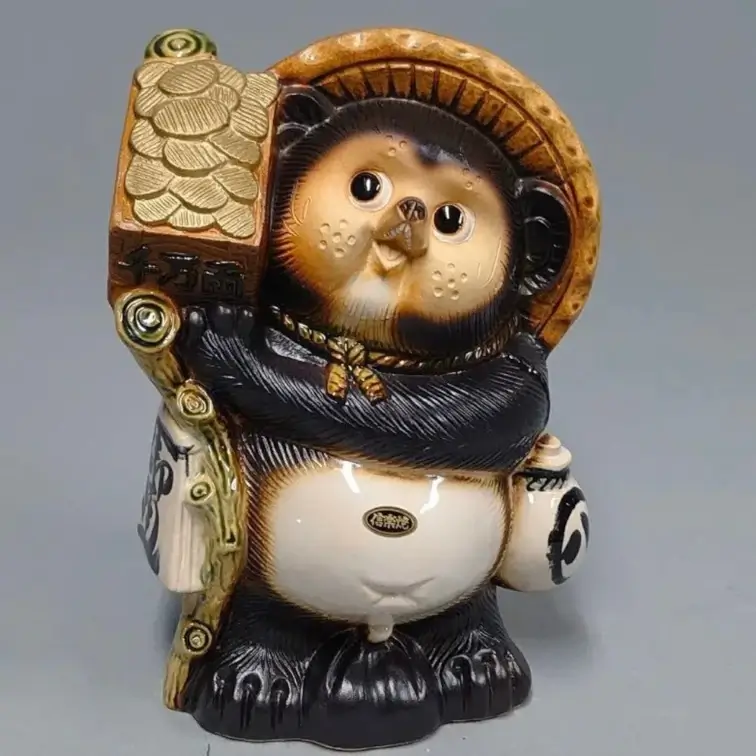
The presence of this being in modern Japanese culture is undeniable, serving as a popular character in video games, television shows and other media. Their influence extends beyond entertainment, even reaching Japanese cuisine, where “Tanuki Soba” becomes a culinary homage to these enchanting creatures.
The Tanuki’s transformation from a feared being of fairy tales to an emblem of joy and good fortune reflects the evolution of its role within Japan’s cultural tapestry. As we progress, we will see how these mythological beings continue to influence modern Japanese society, keeping alive the rich heritage of their folklore.
Tanuki Figures in Modern Society
In modern Japanese society, Tanuki figures have transcended their traditional role to become ubiquitous symbols of culture, art and hospitality. Their image has been integrated into multiple aspects of everyday life, from restaurant decoration to the creation of themed merchandising.
The entertainment industry has enthusiastically embraced them, bringing them to life in movies, television shows and theatrical performances. These characterizations highlight the Tanuki’s transformative abilities and clever tricks, delighting audiences with their comedic adventures.
In addition, the influence of this raccoon dog extends, as I mentioned, to the culinary field, with the “Tanuki Soba” as an example. This culinary presence is complemented by a variety of objects, from key chains to stuffed toys, allowing to have the charming creature in homes.
Its to modern times reflects its benevolent side, as told in traditional stories where the creatures, in return for a little kindness, repay with protection and luck. This positive aspect has materialized in the figure of the modern Tanuki, mainly depicted as a statue with a round belly, straw hat and large eyes, commonly placed outside stores and restaurants as an omen of good fortune.
The current representation of the Tanuki, which was popularized in the 20th century by the potter Fujiwara Tetsuzō, has come to symbolize auspicious virtues, making it a commercial emblem of good luck. This evolution from a mythical creature to a symbol of commercial prosperity illustrates its ability to adapt and remain relevant in contemporary Japanese society.
How to Identify an Authentic Tanuki Figure
Identifying an authentic Tanuki figure in modern Japanese society requires an attentive eye for the details that distinguish these statues, not just as mere ornaments, but as bearers of a rich cultural tradition. These spirit animals are commonly depicted with exaggerated features such as large eyes, a prominent belly and, on many occasions, disproportionately large testicles, symbolizing fortune and prosperity.
A distinctive feature of authentic Tanuki sculptures is the straw hat they usually wear, a symbol of protection against adversity and bad luck. In addition, the presence of elements such as the sake bottle underlines their connection to joy and celebration, essential aspects of their essence.
In the modern context, Tanuki figurines have been adapted to reflect contemporary virtues and aspirations, while maintaining their traditional essence. They can be found in a variety of locations, from restaurant entrances to domestic gardens, where they continue to play their role as symbols of hospitality and good luck.
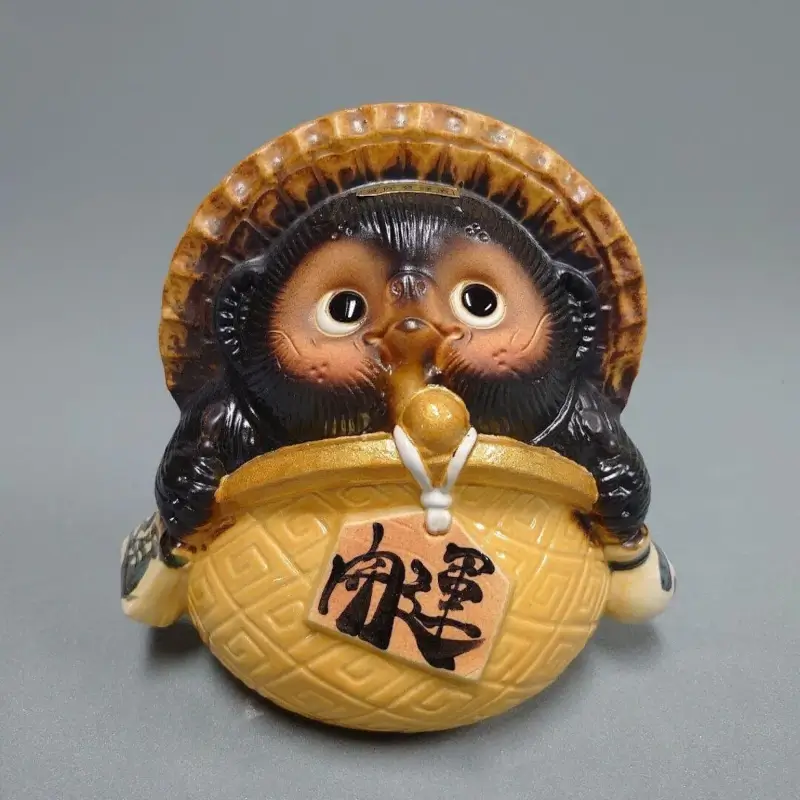
The authenticity of a Tanuki sculpture can also be discerned by the quality of its craftsmanship, especially in regions such as Shigaraki, known for its high-quality pottery. Authentic Tanuki ware figurines from Shigaraki are prized for their artistic detail and richness of finish, making them coveted collector’s items as well as good fortune charms.
When searching for an authentic Tanuki piece, it is crucial to consider these distinctive elements and the history that each statue carries with it. This knowledge not only enriches the appreciation of these works, but also connects the possessor to a deep Japanese cultural heritage that continues to flourish in modern society.
Rituals and Beliefs Associated with Tanuki
In Japan’s rich mythology, the Tanuki occupies a special place, shrouded in an amalgam of rituals and beliefs that highlight its mischievous nature and its ability to influence human affairs. Considered a type of yōkai called Henge, or shapeshifter, the Tanuki, along with the Kitsune, is famous for its natural magical powers. In many legends, the Tanuki and Kitsune shape-shift into humans to commit mischievous acts, enjoying tricking humans in any way possible.
The symbolism and cultural significance of the Tanuki provide a richer understanding of these fascinating creatures. From their symbolic depictions to their role as harbingers of good fortune, this endearing raccoon dog holds a special place in Japanese culture. They are associated with protection, wisdom, benevolence and, most importantly, prosperity and good luck. In modern society, the Tanuki figure has become a popular talisman of good fortune, often displayed in homes, businesses and gardens.
The best works in Japanese ceramics
Traditional stories, such as Bunbuku Chagama, tell how the Tanuki, in return for a little kindness, repay with protection and luck. These stories underscore the belief that kindness to the Tanuki can result in mutual benefits.
Interestingly, the Tanuki are said to love fish and “toasted beans,” and there is a belief that leaving food for them can attract their favor. The presence of the Tanuki in popular culture, especially in statuettes with a round belly, straw hat and large eyes, is a thoroughly positive modern manifestation of this creature, a significant evolution from its more malevolent origins.
This shift from being associated with bad omens to being seen as a symbol of benevolence, prosperity and fun reflects a change in the cultural perception of these beings.
Royal Tanuki Conservation: Efforts and Challenges
I would like to mention here the real animals on which the mythological figure is based and their survival.
The conservation of the Royal Tanuki in Japan presents both successes and significant challenges. Classified by the IUCN as of “least concern,” the Tanuki enjoys a wide distribution and abundant population in Japan, reflecting its resilience and adaptability. However, they face threats due to urbanization and habitat fragmentation, which alter their natural environments and put them at risk.
In addition, the hunting of Tanuki in Japan, primarily to prevent crop damage and for their fur, used in calligraphy brushes, highlights the ongoing human interaction with these creatures. The considerable number of Tanukis that fall victim to vehicular accidents each year underscores the need for effective conservation strategies to mitigate these losses.
The diversity of wildlife in Japan, including the Tanuki, is vital for ecological balance and human well-being. The creation of national parks, wildlife sanctuaries and protected areas is essential to ensure the protection of species, especially endemic ones. However, Japan faces challenges such as urbanization, habitat fragmentation and climate change, which threaten its biodiversity.
To overcome these obstacles, it is crucial to adopt sustainable biodiversity management practices by promoting habitat restoration, implementing stricter regulations, and increasing public awareness of the importance of conservation. Integrating conservation efforts with urban planning and sustainable development will enable the harmonious coexistence of nature and Japanese society, ensuring the protection of unique species such as the Tanuki for future generations.
We hope you liked this post. It will help us if you share it on social networks 👍.
